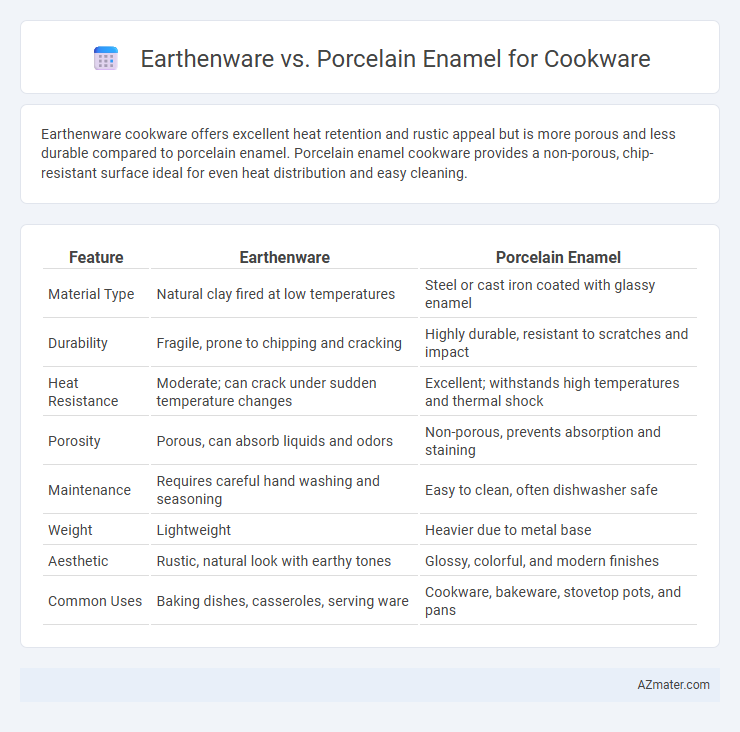Earthenware cookware offers excellent heat retention and rustic appeal but is more porous and less durable compared to porcelain enamel. Porcelain enamel cookware provides a non-porous, chip-resistant surface ideal for even heat distribution and easy cleaning.
Table of Comparison
| Feature | Earthenware | Porcelain Enamel |
|---|---|---|
| Material Type | Natural clay fired at low temperatures | Steel or cast iron coated with glassy enamel |
| Durability | Fragile, prone to chipping and cracking | Highly durable, resistant to scratches and impact |
| Heat Resistance | Moderate; can crack under sudden temperature changes | Excellent; withstands high temperatures and thermal shock |
| Porosity | Porous, can absorb liquids and odors | Non-porous, prevents absorption and staining |
| Maintenance | Requires careful hand washing and seasoning | Easy to clean, often dishwasher safe |
| Weight | Lightweight | Heavier due to metal base |
| Aesthetic | Rustic, natural look with earthy tones | Glossy, colorful, and modern finishes |
| Common Uses | Baking dishes, casseroles, serving ware | Cookware, bakeware, stovetop pots, and pans |
Introduction: Understanding Earthenware and Porcelain Enamel Cookware
Earthenware cookware, made from natural clay fired at lower temperatures, offers excellent heat retention and a rustic aesthetic favored for slow cooking and baking. Porcelain enamel cookware features a metal core coated with a smooth, durable porcelain enamel layer, combining the strength of metal with a non-reactive, easy-to-clean surface. Understanding the material properties and heat distribution of both types is essential for choosing cookware that suits specific cooking methods and maintenance preferences.
Material Composition: What Are Earthenware and Porcelain Enamel?
Earthenware cookware is made from natural clay fired at lower temperatures, resulting in a porous, slightly fragile material often coated with a glaze to improve durability and food safety. Porcelain enamel cookware consists of a metal core, typically cast iron or steel, coated with a smooth, glass-like porcelain enamel layer that provides a non-porous, highly durable, and corrosion-resistant surface. Understanding the differences in material composition helps in selecting cookware based on heat retention, durability, and maintenance preferences.
Heat Retention and Distribution
Earthenware cookware offers excellent heat retention due to its thick, porous structure, maintaining warmth for extended cooking periods, but it often distributes heat unevenly, causing hotspots. Porcelain enamel cookware, coated on metal bases like cast iron or steel, provides superior heat distribution, ensuring consistent cooking temperatures across the surface while retaining heat effectively thanks to the underlying metal core. Choosing between these materials depends on the need for steady heat retention versus uniform heat diffusion during cooking.
Cooking Versatility and Compatibility
Earthenware cookware offers excellent heat retention and is ideal for slow cooking and baking but is not suitable for high temperatures or induction cooktops. Porcelain enamel cookware provides superior versatility, compatible with all stovetops including induction, and withstands high heat, making it perfect for searing, sauteing, and boiling. Choosing between them depends on cooking methods and appliance compatibility, with porcelain enamel suited for multi-functional use and earthenware best for gentle, consistent heating.
Durability and Longevity
Earthenware cookware is porous and prone to chipping or cracking over time, making it less durable compared to porcelain enamel. Porcelain enamel features a glassy, hard coating bonded to a metal base, offering superior resistance to scratches, stains, and thermal shock. This coating ensures greater longevity and maintains cookware performance through extended use and high temperatures.
Maintenance and Cleaning Requirements
Earthenware cookware requires careful hand washing with mild detergents to prevent cracks and maintain its porous surface, avoiding sudden temperature changes that can cause damage. Porcelain enamel offers a more durable, non-porous surface that resists staining and is easier to clean, often dishwasher safe, but it may chip if dropped or subjected to heavy impact. Proper maintenance of earthenware involves seasoning and avoiding abrasive scrubbing, whereas porcelain enamel demands gentle cleaning to preserve its glossy finish and prevent chipping.
Safety and Health Considerations
Earthenware cookware is generally porous and can absorb liquids and bacteria if not properly glazed, raising concerns about potential contamination and leaching of harmful substances. Porcelain enamel cookware features a non-porous, glass-like coating fused to metal, providing a safer, non-reactive surface that resists chemical leaching and simplifies cleaning. Choosing porcelain enamel reduces risks related to toxins and bacterial growth, making it a healthier option for long-term cooking use.
Aesthetic Appeal and Design Options
Earthenware cookware offers a rustic, handcrafted aesthetic with warm, earthy tones and unique glaze patterns that enhance kitchen decor with a natural charm. Porcelain enamel cookware provides a sleek, glossy finish available in a wide spectrum of vibrant colors and intricate designs, appealing to modern and eclectic tastes. Both materials allow customization, but porcelain enamel excels in durability and color retention for long-lasting visual appeal.
Price Comparison: Affordability and Value
Earthenware cookware typically offers greater affordability, with prices often ranging from $20 to $100, making it accessible for budget-conscious buyers. Porcelain enamel cookware commands higher prices, usually between $50 and $300, reflecting its durability and aesthetic appeal. While earthenware emphasizes cost-effectiveness, porcelain enamel provides enhanced longevity and non-reactive surfaces, delivering better value over time despite the initial investment.
Choosing the Right Cookware for Your Needs
Earthenware offers excellent heat retention and rustic charm, making it ideal for slow cooking and serving, while porcelain enamel provides a durable, non-reactive surface resistant to staining and chipping, suitable for high-heat cooking and easy maintenance. Choosing the right cookware depends on cooking style, with earthenware best for gentle simmering and porcelain enamel preferred for versatile, heavy-duty use. Consider factors like heat distribution, cleaning ease, and aesthetic preferences to match cookware performance with your culinary requirements.

Infographic: Earthenware vs Porcelain Enamel for Cookware
 azmater.com
azmater.com